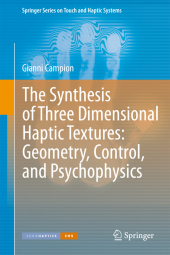 Neuerscheinungen 2013Stand: 2020-01-07 |
Schnellsuche
ISBN/Stichwort/Autor
|
Herderstraße 10
10625 Berlin
Tel.: 030 315 714 16
Fax 030 315 714 14
info@buchspektrum.de |

Gianni Campion
The Synthesis of Three Dimensional Haptic Textures: Geometry, Control, and Psychophysics
2013. xx, 160 S. 6 Tabellen. 235 mm
Verlag/Jahr: SPRINGER, BERLIN 2013
ISBN: 1-447-12654-8 (1447126548)
Neue ISBN: 978-1-447-12654-6 (9781447126546)
Preis und Lieferzeit: Bitte klicken
This literature review on haptic textures examines the problem of rendering virtual haptic textures with force-feedback devices. It provides a thorough grounding in the subject and includes tools for analyzing the textures that a haptic device can produce.
The sense of touch is fundamental during the interaction between humans and their environment; in virtual reality, objects are created by computer simulations and they can be experienced through haptic devices. In this context haptic textures are fundamental for a realistic haptic perception of virtual objects.
This book formalizes the specific artefacts corrupting the rendering of virtual haptic textures and offers a set of simple conditions to guide haptic researchers towards artefact-free textures. The conditions identified are also extremely valuable when designing psychophysical experiments and when analyzing the significance of the data collected.
The Synthesis of Three Dimensional Haptic Textures, Geometry, Control, and Psychophysics examines the problem of rendering virtual haptic textures with force feedback devices. The author provides an introduction to the topic of haptic textures that covers the basics of the physiology of the skin, the psychophysics of roughness perception, and the engineering challenges behind haptic textures rendering. The book continues with the presentation of a novel mathematical framework that characterizes haptic devices, texturing algorithms and their ability to generate realistic haptic textures. Finally, two psychophysical experiments link the perception of roughness with the parameters of the haptic rendering algorithms.
This book formalizes the specific artefacts corrupting the rendering of virtual haptic textures and offers a set of simple conditions to guide haptic researchers towards artefact-free textures. The conditions identified are also extremely valuable when designing psychophysical experiments and when analyzing the significance of the data collected.
Introduction.-Literature Review.-The Pantograph Mk-II: A Haptic Instrument.-Fundamental Limits.-On the Synthesis of Haptic Textures.- Passive Realization of Nonlinear Virtual Environments.-Texturing Curved Surfaces.-Roughness of Virtual Textures and Lateral Force Modulation.- Calibration of Virtual Haptic Texture Algorithms.-Conclusions


